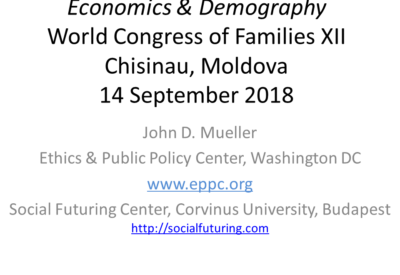
Published September 14, 2018
World Congress of Families
The following presentation was delivered by EPPC Lehrman Institute Fellow in Economics John D. Mueller at the World Congress of Families in Chisinau, Moldova, on September 14, 2018.
In an April 2019 video produced by the Social Futuring Center, Mr. Mueller offered commentary related to the presentation below:
- with Hungarian subtitles: https://youtu.be/6alU4PA0kYY
- with Chinese subtitles: https://youtu.be/8gOgrMnh19w
To a first-time visitor from the United States, Moldova presents an attractive combination of the foreign and the familiar. Perhaps as a result of hosting the Twelfth World Congress of Families, Moldova is also becoming “familiar” in another sense—pointing out the fundamental and universal importance of the family.
In these brief remarks I would like to answer two questions: first, why has the birth rate fallen in nearly every country in the world, which Moldova’s President Igor Dodon rightly called a “catastrophe”? Second, I will try to answer the question pointedly posed this morning by Levan Vasadze of Georgia, who hosted the Tenth World Congress there: Why has discussion of the family been shifting from West to East? In the process I will describe a new pro-family Social Futuring Index (SFI), on which I have worked with experts from the Social Futuring Center (SFC) at the Corvinus University of Budapest (CUB).
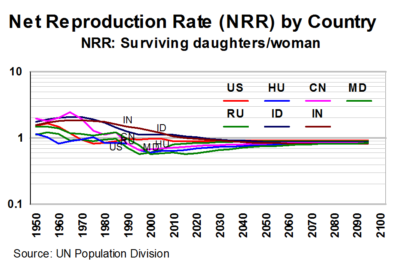
To answer the first question, let’s start with the raw facts, using a measure which demographers call the Net Reproduction Rate (NRR), which is the average number of surviving daughters borne by each woman in her lifetime. In some important ways, the NRR is simpler and more informative than the better-known Total Fertility Rate (TFR), which is the average number of children born to each woman in her lifetime, ignoring the mortality rate of both women and their children.
I have attended most World Congresses of Families since Warsaw in 2007. At each one, I have described the results and forecasts of a simple yet remarkably accurate country-by-country model of fertility, which was ultimately published in my book Redeeming Economics: Rediscovering the Missing Element. The model contains only four variables, one positive and three negative.
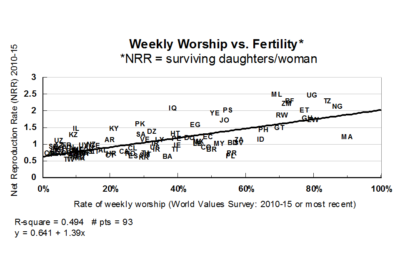
The only positive variable is the rate of weekly worship, usually measured by the World Values Survey (WVS). As you can see, this one variable alone explains almost exactly half the variation in fertility among the nearly 100 countries for which data are available. The chart shows that in 2010-2015, the average woman who never worshiped had less than two-thirds of a daughter, corresponding to a total fertility rate (adjusted for mortality) of about 1.3 children. Yet the women who worshiped at least once a week had an average of about 2 daughters, or about 4 children.
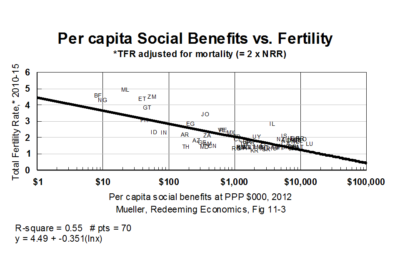
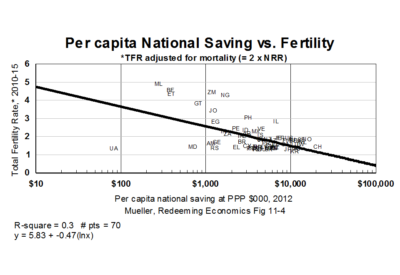
The other three variables have negative relationships with the birth rate: per capita social benefits and per capita national saving (both adjusted for differences in purchasing power). Per capita social benefits and per capita national saving have strong negative relationships with fertility because they are in effect economic substitutes for having grown children to support oneself in old age or retirement. The other negative variable, not shown here, is a country having a totalitarian legacy, such as communist occupation (or also apartheid in South Africa. Even apart from the other variables, a totalitarian legacy reduced NRR by about one-third, and the mortality-adjusted Total Fertility Rate by about two-thirds of a child.

Together, these four factors explain about seven-eighths of the variation in the birth rate of those countries for which we have data.
By one count, there are about a dozen different indicators of human well-being, each with an associated database. Perhaps the most famous and widely used is the Human Development Index (HDI). But each existing index seems either to leave out some essential feature of human nature, be less than coherent, so complicated as to be incomprehensible and/or unwieldy in informing national policy decisions.
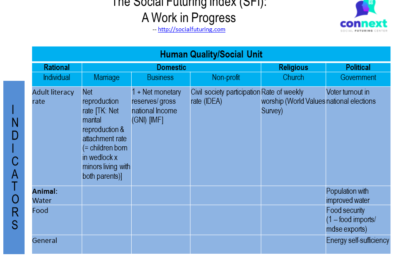
I have been working with the Social Futuring Center (SFC) at Corvinus University in Budapest — http://socialfuturing.com/ — to develop a “Social Futuring Index” (SFI). Despite its New Agey-sounding title, the SFC combines the fruits of more than 2,000 years of philosophical reflection on the topic with solid techniques of modern social science. The SFI views man, as the “AAAs”—Aristotle, Augustine and Aquinas—described him, as essentially a “rational,” “conjugal,” “spiritual,” and “political animal.” The Social Futuring Index (SFI) tries to capture these essential features of human flourishing in a way which is both comprehensive and comprehensible, in order to help policymakers see how well their country is doing in these respects, and pursue policies that will help their citizens to flourish.
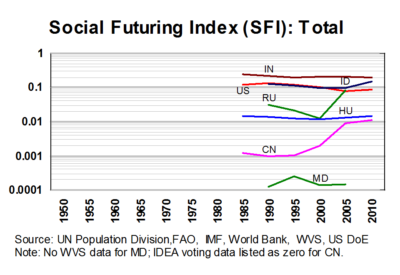
I have labeled the SFI “a work in progress,” since it is. Yet even in a preliminary form, the SFI yields important information.
Ultimately, it should be possible to calculate the SFI for about 100 countries. So far, there are complete calculations only for the four most populous countries—China, India, the United States and Indonesia—as well as Russia, Hungary and Moldova.
Of those countries, India was the highest Total SFI, at about 0.11, followed by Indonesia and the United States. But other countries, particularly those which have made or are making the transition from communism to representative government, while scoring much lower, have been rising the most rapidly.
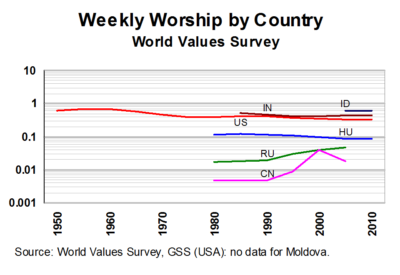
The data show the importance of spiritual factors in people’s behavior. The SFI contains both the NRR, which reflects the “conjugal” facet of human nature and the rate of weekly worship, which reflects the spiritual aspect of human nature, which, as we have seen, are closely related.
The typical couple in the world today which never worships has about 1.2 children. But the average couple which worships at least weekly has about 4 children. In other words, humans who act on the assumption that there is a next life reproduce themselves in this one. These behavioral differences also vary surprisingly little by specific religion or religious denomination.
The relationship suggests that humans who act on the assumption that there is a next life reproduce themselves in this one. These behavioral differences also vary surprisingly little by specific religion or religious denomination.
Finally to answer the second question, the initiative on the family has shifted from West to East because weekly worship, while higher in the West, has been falling, while in the East, though low, worship, and with it fertility, has been rising.
Appendix: Elements of the Social Futuring Index

Man’s rational nature is approximated by the Adult Literacy Rate (ALR). His “conjugal” nature is measured by the Net Reproduction Rate (NRR)—the number of surviving daughters borne by each woman. When fully developed, this component will be the “Net Reproduction and Attachment Rate” (NRAR)—adding to the NRR the rate at which children are borne within wedlock and the share of minor children living with both biological parents.
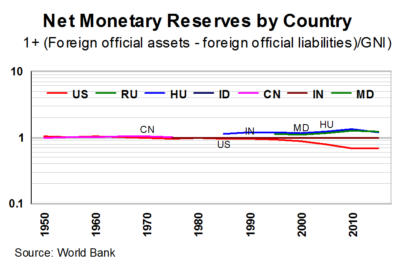
A nation’s general economic preparation for emergencies is proxied by (1 + net monetary reserves [official monetary assets minus liabilities]/gross national income [GNI]).
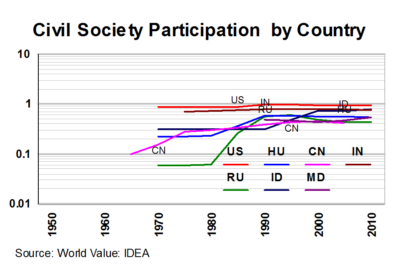
The cultural aspect of human life is measured by the civil society participation rate, as estimated by IDEA (the Institute of Democracy and Electoral Assistance). As we have seen, man’s spiritual nature is reflected in the rate of weekly worship.
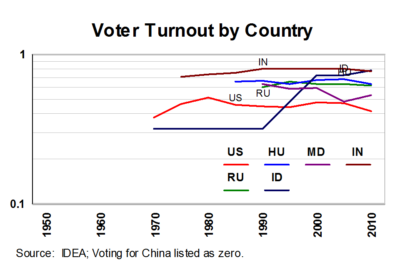
Man’s political nature is reflected in national voter turnout.

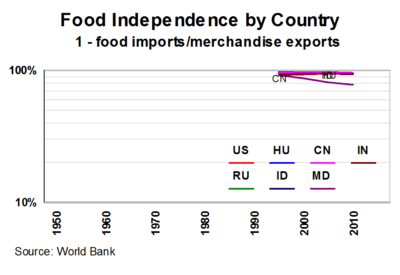
And man’s animal nature is reflected in the share of the population with improved water and with food security (measured by the U.N.’s Food and Agricultural Organization [FAO]) as (1 – food imports/ total merchandise exports).

General provision for man’s animal needs is reflected in each country’s degree of energy self-sufficiency (as estimated by the U.S. Department of Energy). Together, these nine indicators offer a comprehensive yet relatively simple framework for determining the degree to which any country is providing adequately for its own future.
The Social Futuring Index is multiplicative, meaning that its components, which range from zero to a maximum of at least 1, are multiplied, so that the total SFI for any country is lower than any of its individual components. The SFC plans to publish estimates for about 100 countries. But so far, the estimates are limited to the four most populous countries—China, India, the USA, and Indonesia—as well as Russia, Hungary (where the Social Futuring Center is located), and Moldova (is hosting the 2018 World Congress of Families). The preliminary estimates indicate that every country falls short in various ways. Of the countries mentioned, India has the highest total SFI, closely followed by Indonesia, and the United States. But despite more variation, China and Russia have shown the most rapid improvement in relative terms.

China. The Net Reproduction Rate (NRR) for China has fallen substantially, as in most industrial countries. But participation in civil society has risen steadily (even though IDEA lists voter turnout as zero because it does not have representative government). And though the rate of weekly worship is much lower than in most other industrial countries, it has risen substantially in China, contributing to the tenfold rise in China’s total SFI in recent decades.
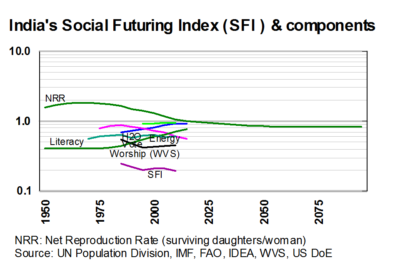
India. As mentioned, India has the highest SFI, largely because its birth rate and rate of weekly worship, which, though both have fallen, have remained higher than in most other major countries. India’s adult literacy rate has risen substantially, though both India’s energy independence and rate of voter participation have fallen.
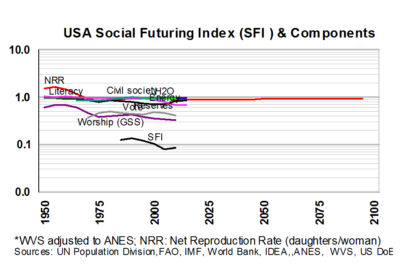
The United States. The Social Futuring Index (SFI) for the United States of America has generally declined in recent decades, as the combined result of lower fertility, a fall in the rate of weekly worship, and a substantial decline in net monetary reserves, the latter due primarily to the U.S. dollar’s role as chief official “reserve currency.” However, the USA’s rate of energy independence has recovered substantially after earlier declines.

Indonesia. The Social Futuring Index (SFI) for Indonesia, the fourth most populous country in the world, matched that of the USA, which is third-largest, for the periods for which data are available from 1985-1990 through 2000-2005, when the SFIs for both countries were gently declining. But Indonesia’s SFI rose significantly in the two most recent 5-year intervals while that for the USA continued to decline. This difference was due mostly to higher rates of fertility, weekly worship and voting in Indonesia than in the USA.
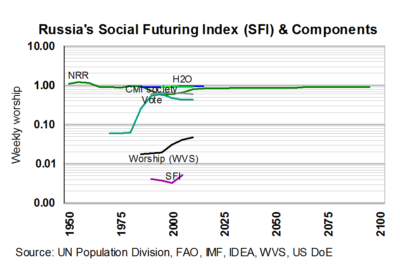
Russia. Some of Russia’s indicators, such as the rise in rates of participation in civil society and weekly worship, reflect the country’s emergence from more than eight decades of communist government. Most of the sharp fall in the birth rate which occurred during and after the transition from communism, has been made up, according to the U.N.’s Population Division.

Hungary. On balance, Hungary’s Social Futuring Index (SFI) has increased since 2000, after declining in the two previous decades. As with Russia, many of Hungary’s indicators reflect the country’s emergence from decades of communist government, though some indicators date only from the period since the transition. Unfortunately, many indicators also contain gaps, as with the rate of weekly worship, for which the World Values Survey (WVS) often did not include Hungary. But it has seemed reasonable to interpolate intermediate data points where data are missing.
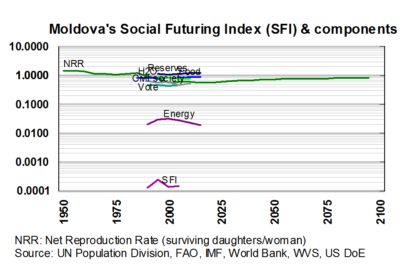
Moldova. Moldova is the smallest country surveyed for this study. It also presents the greatest problems in measuring the Social Futuring Index (SFI). Moldova was not included in any “wave” of the World Values Survey. Like Russia and Hungary, it lived under communist government. Moldova is also the country most dependent on foreign energy of those countries surveyed. Its birth rate has fallen, but is projected to recover in coming decades.
